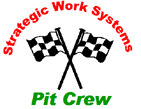I had just finished a conference presentation on NASCAR Racing: a Model for Equipment Reliability and Teamwork when I was asked this question by a top manager from one of our country’s largest businesses, which I will call “the Company.” He is responsible for the procurement and installation on hundreds of millions of dollars of next-generation newtechnology equipment. “In order to meet our project and cost goals, we have to cut somewhere. So which is more important: maintenance or training?” I was speechless. He was in a hurry. So I gave him a 60 second blast that ended with this: “The equipment will fail to do what you expect it to do without proper training and maintenance. Unfortunately, these are the historical first-tobe-cut budget items, which is a prescription for failure. Especially now: Maintenance and training should be a top priority as we are in the midst of an ever-worsening shortage of skilled and qualified maintenance people in the U.S.”
The Company’s next-generation new-technology equipment was designed and developed over the past several years at great expense to significantly improve their business efficiency (accuracy and volume) and lower the Company’s operating costs in one of their growth markets. Now this Company is about to shoot themselves in their proverbial foot. How can they spend hundreds of millions of dollars on equipment development, procurement, and installation to improve their competitive position and not spend the necessary resources to make it operate reliably as designed for the next 10, 15, or 20 years? It continues to puzzle me. For more than 30 years, I have seen this “cost-cutting, project-completion mindset” prevent equipment investments from achieving their intended results.
Manufacturers of the new-technology equipment recommended about 4,000 hours per year for routine maintenance. However, the Company is budgeting approximately 2,000 hours per year. How can they properly maintain the equipment if the hours are not budgeted? Regardless if you budget for it or not, when the equipment breaks down it must be fixed. What these decisionmakers often fail to realize is that the repairs can cost 10 to 100 times that of thorough preventive maintenance when you consider parts, labor, and the lost production revenues, not to mention customer dissatisfaction and opening the door to the competition in growth markets.
The bottom line with his “maintenance question” is not whether to cut maintenance costs but rather to ask “what does the equipment truly require to perform reliably – to do what we need it to do first time every time?” Then, how can we make the equipment require less maintenance (maintenance prevention design/modification)? What can we do to make maintenance and operations easier to perform (maintainability and operability)? And what can we do to improve preventive maintenance efficiency (running PMs, condition monitoring, and predictive maintenance)?
The bottom line with his “training question” is not whether to cut training costs but rather to ask “what does the equipment truly require people to know and to do to keep the equipment running reliably?” Because if people are not trained and qualified to properly operate and maintain the equipment, their mistakes and trial-and-error methods will results in damaged equipment, delays, and unprocessed products. Troubleshooting and problem solving demand a working knowledge of the equipment. Without that knowledge, we quickly become parts replacers and the quest for
the bigger hammer begins. People are the single biggest cause of equipment problems; the decisions they make and the things they do with the equipment cause failures throughout the equipment lifecycle.
My training recommendation: Do not cut back on equipment-specific training in any manner. Make it more efficient and more effective. Make sure that all of the operators and maintainers have the necessary “core skills and knowledge” or the prerequisite skills to comprehend and apply the equipment-specifics. Then, apply visuals to every critical component and indicate every critical operating parameter on the equipment. Consider gauge labels and marked operating ranges. Physically locate and identify every lubrication point on the equipment. Colorcode and mark all lube points to indicate type of lube and frequency. Attach lubrication pictorials or diagrams to the equipment indicating the frequency, lube type, and methods. Open up every guard with Lexan® or expanded metal mesh “windows” to allow easier running inspections. Match-mark all critical nuts, bolts, and fittings making it easier to spot looseness. Label every major component with its name and identification number so everyone uses the same terminology, thus improving communications and equipment repair and maintenance history accuracy. Label replacement part numbers and sizes for belts, filters, and light bulbs. Locate all vibration analysis pickup points with labeled discs on critical motors and drives to improve accuracy of readings. The bottom line here is to make it easier to spot problems and to error proof operations and maintenance. These “visuals” also serve as a constant reminder of what was taught in the initial training sessions.
And finally, hold the equipment manufacturers and system integrators responsible for the timely delivery of all documentation for maintenance and training: Maintenance manuals, operating instructions, troubleshooting charts, drawings, diagrams, ladder logic, and specifications. These should be available prior to equipment installation. Historically however, this “paperwork” tends to be a low priority.
Maintenance defined: sustaining the desired level of performance (not fixing things that break). If you think maintenance is expensive, what about the cost of no maintenance? If you think education and training are expensive, what about the cost of ignorance? Not knowing what the equipment requires for reliable operation throughout its life cycle can be easily corrected and then proper actions can then be taken. But making such decisions based on project and operating budgets rather than equipment requirements is frightening! And “There is nothing more frightful than ignorance in action” (Johann Wolfgang von Goethe, German dramatist, novelist, poet, & scientist, 1749-1832).
©2004 Robert M. Williamson
Strategic Work Systems, Inc.
PO Box 70, Columbus, NC 28722
RobertMW2@cs.com
Download a copy of the document here: Cut maintenance or training
